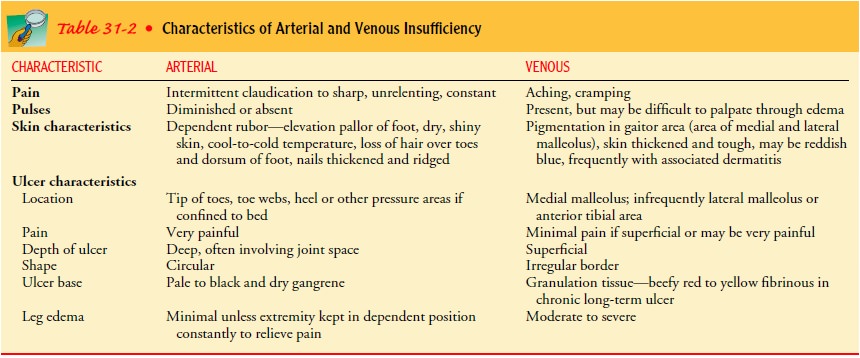Chapter: Medical Surgical Nursing: Vascular Disorders and Problems of Peripheral Circulation
Pathophysiology of the Vascular System
PATHOPHYSIOLOGY
OF THE VASCULAR SYSTEM
Reduced
blood flow through peripheral blood vessels character-izes all peripheral
vascular diseases. The physiologic effects of al-tered blood flow depend on the
extent to which tissue demands exceed the supply of oxygen and nutrients
available. If tissue needs are high, even modestly reduced blood flow may be
inadequate to maintain tissue integrity. Tissues then fall prey to ischemia
(defi-cient blood supply), become malnourished, and ultimately die if adequate
blood flow is not restored.
Pump Failure
Inadequate
peripheral blood flow occurs when the heart’s pump-ing action becomes
inefficient. Left ventricular failure causes an accumulation of blood in the
lungs and a reduction in forward flow or cardiac output, which results in
inadequate arterial blood flow to the tissues. Right ventricular failure causes
systemic ve-nous congestion and a reduction in forward flow .
Alterations in Blood and Lymphatic Vessels
Intact,
patent, and responsive blood vessels are necessary to de-liver adequate amounts
of oxygen to tissues and to remove meta-bolic wastes. Arteries can become
obstructed by atherosclerotic plaque, a thrombus, or an embolus. Arteries can
become dam-aged or obstructed as a result of chemical or mechanical trauma,
infections or inflammatory processes, vasospastic disorders, and congenital
malformations. A sudden arterial occlusion causes profound and often
irreversible tissue ischemia and tissue death. When arterial occlusions develop
gradually, there is less risk for sudden tissue death because collateral
circulation has an oppor-tunity to develop and the body adapts to the decreased
blood flow.
Venous
blood flow can be reduced by a thrombus obstructing the vein, by incompetent
venous valves, or by a reduction in the effectiveness of the pumping action of
surrounding muscles. De-creased venous blood flow results in increased venous
pressure, a subsequent rise in capillary hydrostatic pressure, net filtration
of fluid out of the capillaries into the interstitial space, and sub-sequent
edema. Edematous tissues cannot receive adequate nu-trition from the blood and
consequently are more susceptible to breakdown, injury, and infection.
Obstruction of lymphatic ves-sels also results in edema. Lymphatic vessels can
become ob-structed by tumor or by damage resulting from mechanical trauma or
inflammatory processes.
Gerontologic Considerations
Aging
produces changes in the walls of the blood vessels that affect the transport of
oxygen and nutrients to the tissues. The intima thickens as a result of
cellular proliferation and fibrosis. Elastin fibers of the media become
calcified, thin, and fragmented, and collagen accumulates in the intima and the
media. These changes cause the vessels to stiffen, which results in increased
peripheral resistance, impaired blood flow, and increased left ventricular
workload.
Circulatory Insufficiency of the Extremities
Although
many types of peripheral vascular diseases exist, most re-sult in ischemia and
produce some of the same symptoms: pain, skin changes, diminished pulse, and
possible edema. The type and severity of symptoms depend in part on the type,
stage, and extent of the disease process and on the speed with which the
disorder develops. Table 31-2 highlights the distinguishing features of
ar-terial and venous insufficiency.

Related Topics